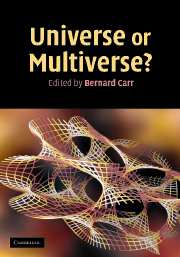Book contents
- Frontmatter
- Contents
- List of contributors
- Preface
- Acknowledgements
- Editorial note
- Part I Overviews
- Part II Cosmology and astrophysics
- Part III Particle physics and quantum theory
- Part IV More general philosophical issues
- 20 Scientific alternatives to the anthropic principle
- 21 Making predictions in a multiverse: conundrums, dangers, coincidences
- 22 Multiverses: description, uniqueness and testing
- 23 Predictions and tests of multiverse theories
- 24 Observation selection theory and cosmological fine-tuning
- 25 Are anthropic arguments, involving multiverses and beyond, legitimate?
- 26 The multiverse hypothesis: a theistic perspective
- 27 Living in a simulated universe
- 28 Universes galore: where will it all end?
- Index
- References
21 - Making predictions in a multiverse: conundrums, dangers, coincidences
Published online by Cambridge University Press: 05 July 2014
- Frontmatter
- Contents
- List of contributors
- Preface
- Acknowledgements
- Editorial note
- Part I Overviews
- Part II Cosmology and astrophysics
- Part III Particle physics and quantum theory
- Part IV More general philosophical issues
- 20 Scientific alternatives to the anthropic principle
- 21 Making predictions in a multiverse: conundrums, dangers, coincidences
- 22 Multiverses: description, uniqueness and testing
- 23 Predictions and tests of multiverse theories
- 24 Observation selection theory and cosmological fine-tuning
- 25 Are anthropic arguments, involving multiverses and beyond, legitimate?
- 26 The multiverse hypothesis: a theistic perspective
- 27 Living in a simulated universe
- 28 Universes galore: where will it all end?
- Index
- References
Summary
Introduction
The standard models of particle physics and cosmology are both rife with numerical parameters that must have values fixed by hand to explain the observed world. The world would be a radically different place if some of these constants took a different value. In particular, it has been argued that if any one of six (or perhaps a few more) numbers did not have rather particular values, then life as we know it would not be possible [1]; atoms would not exist, or no gravitationally bound structures would form in the Universe, or some other calamity would occur that would appear to make the alternative universe a very dull and lifeless place. How, then, did we get so lucky as to be here?
This question is an interesting one because all of the possible answers to it that I have encountered or devised entail very interesting conclusions. An essentially exhaustive list of such answers follows.
(i) We just got very lucky. All of the numbers could have been very different, in which case the Universe would have been barren, but they just happened by pure chance to take values in the tiny part of parameter space that would allow life. We owe our existence to one very, very, very lucky roll of the dice.
(ii) We were not particularly lucky. Almost any set of parameters would have been fine, because life would find a way to arise in nearly any type of universe.
[…]
- Type
- Chapter
- Information
- Universe or Multiverse? , pp. 367 - 386Publisher: Cambridge University PressPrint publication year: 2007
References
- 11
- Cited by



